Abstract
Metals have been evaluated as potential carcinogens by administering pure elements or compounds by a large variety of routes. These include mixing the agent in the food, dissolving the test compound in the drinking water, or administering the material by gavage. The respiratory tract routes tested include inhalation, intratracheal instillation, the direct injection of particulates into the pleural cavity, or the implantation of hooks by surgical intervention. The parenteral routes used were intravenous injection, intraperitoneal injection, subcutaneous implantation, as well as intrafemoral and intramuscular injection. This latter route is the most commonly used. There are major objections to the subcutaneous implantations route, and data generated from these experiments are difficult to interpret for the foreign body reaction may give rise also to fibrosarcomas. This then is a nonspecific reaction. Exotic routes tested include intrarenal, intratesticular, and intracranial injections. The endpoints of the carcinogenic reactions are, in the main, sarcomas of certain types with fibrosarcomas predominating. Rhabdomyosarcomas are the next most frequent cancer found, and squamous cell carcinoma may account for less than 2% of the cancers reported. Much more research is necessary to clarify the nature of metal carcinogenesis. Dose-response information is almost nonexistent; the divided dose problem has not been studied adequately, and very little information is available on interspecies reactions. More work is needed to help interpret the mechanism of action.
Full text
PDF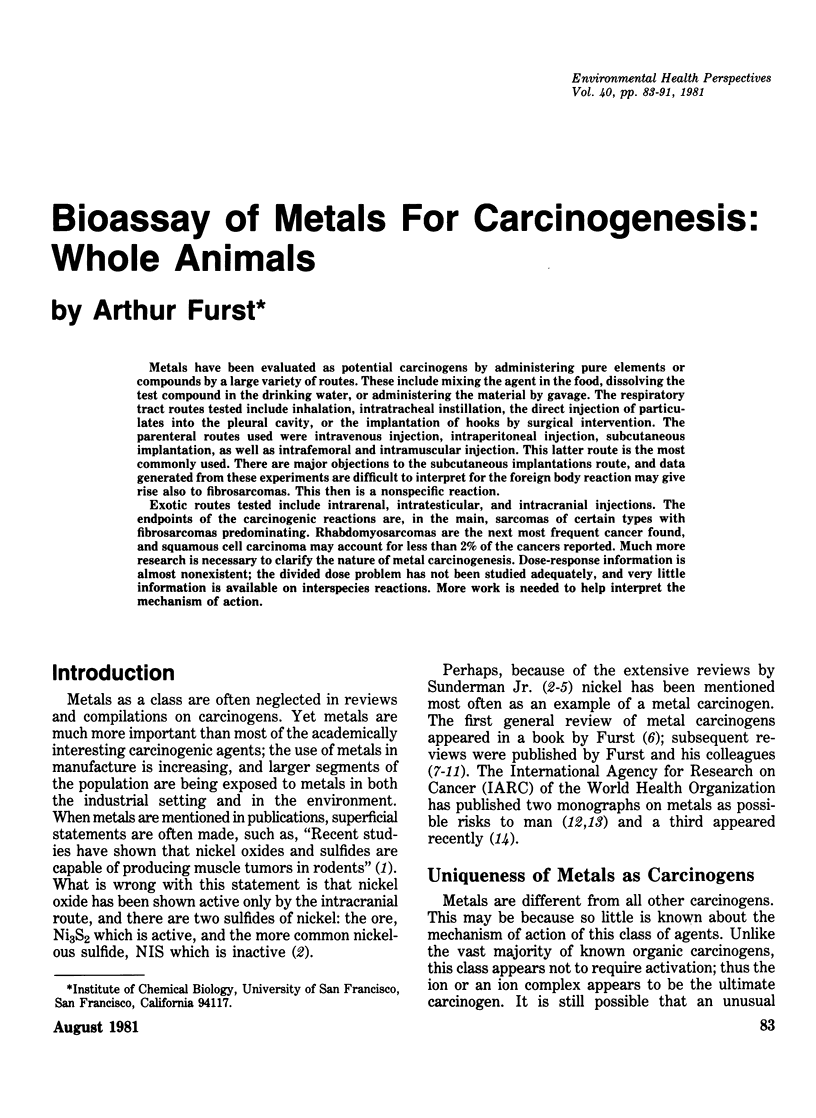
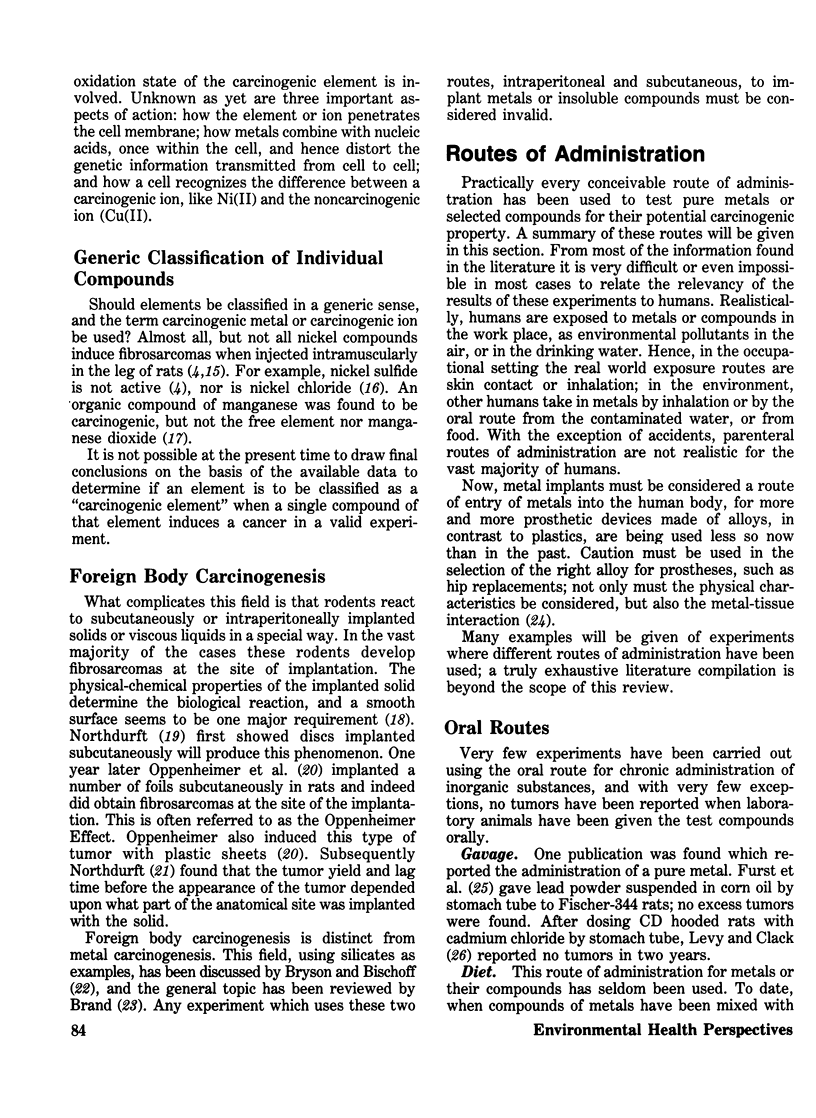


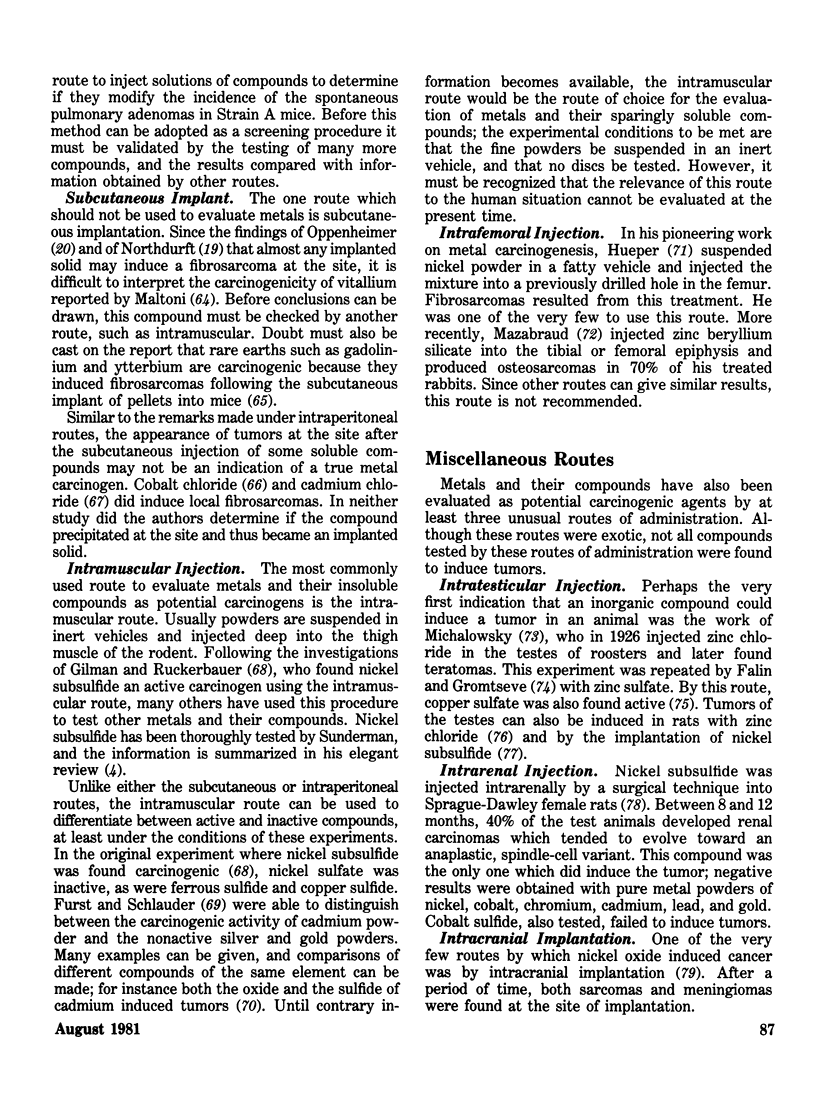
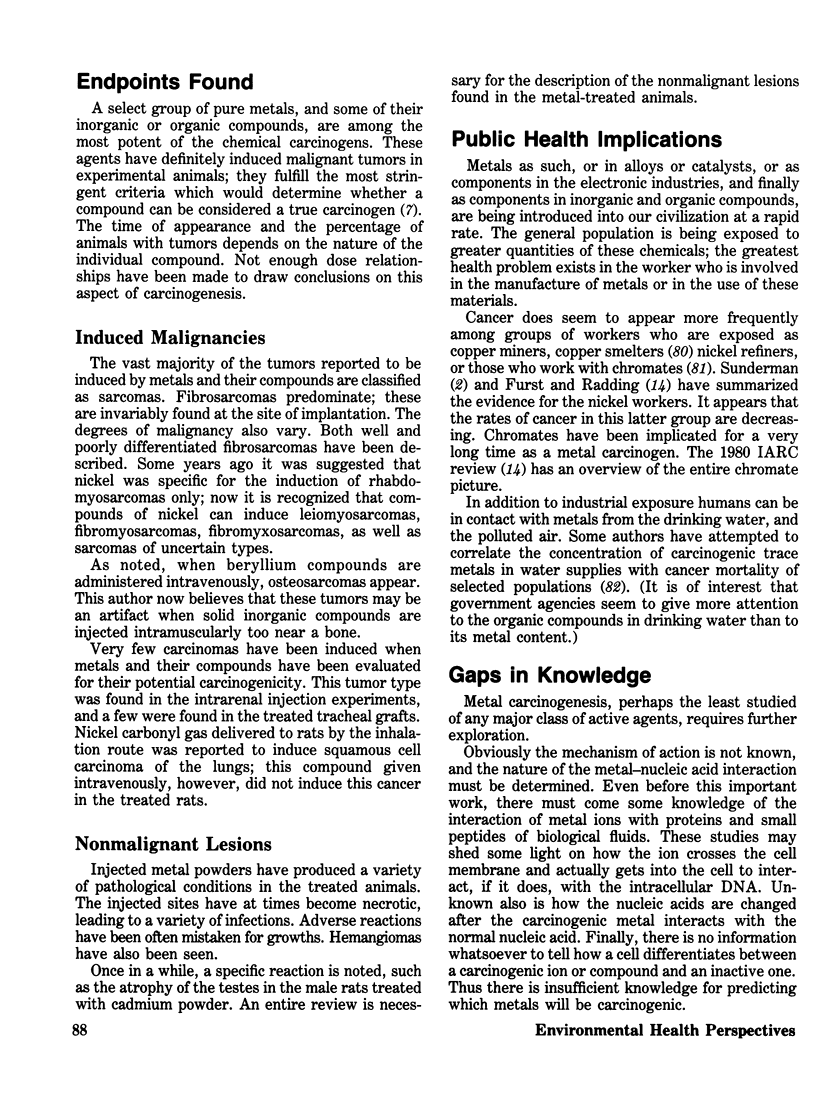
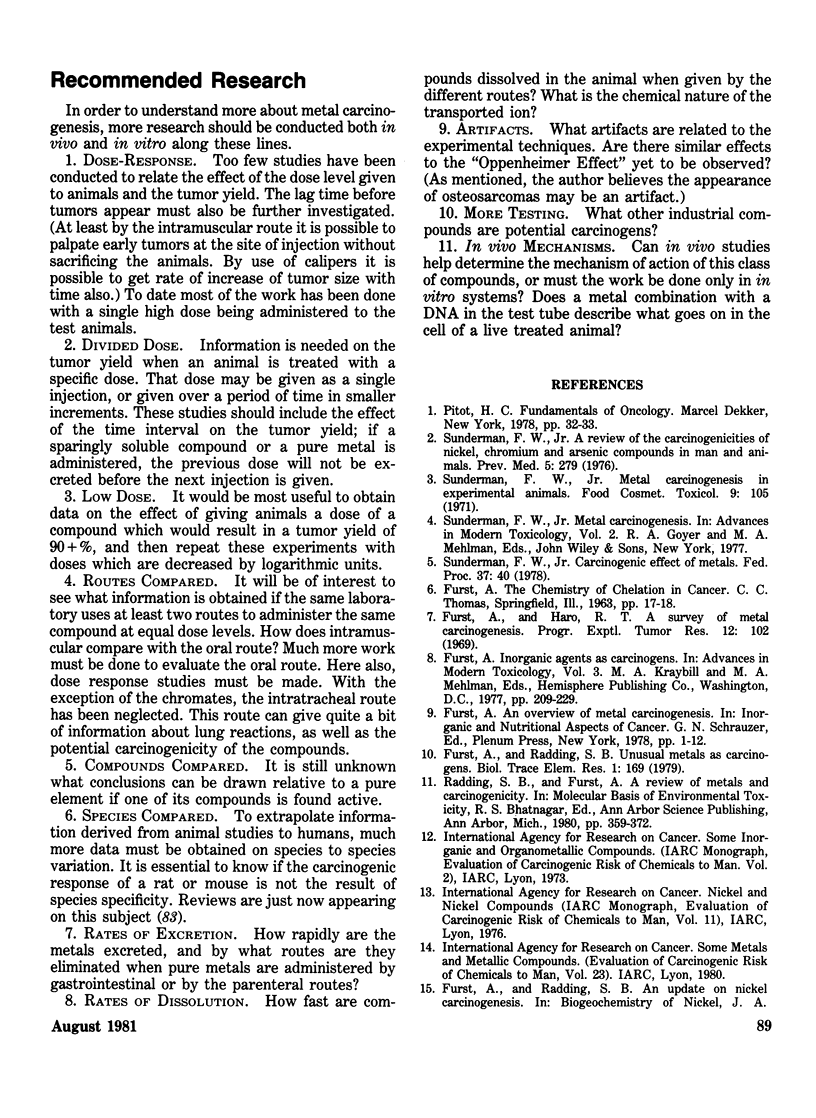
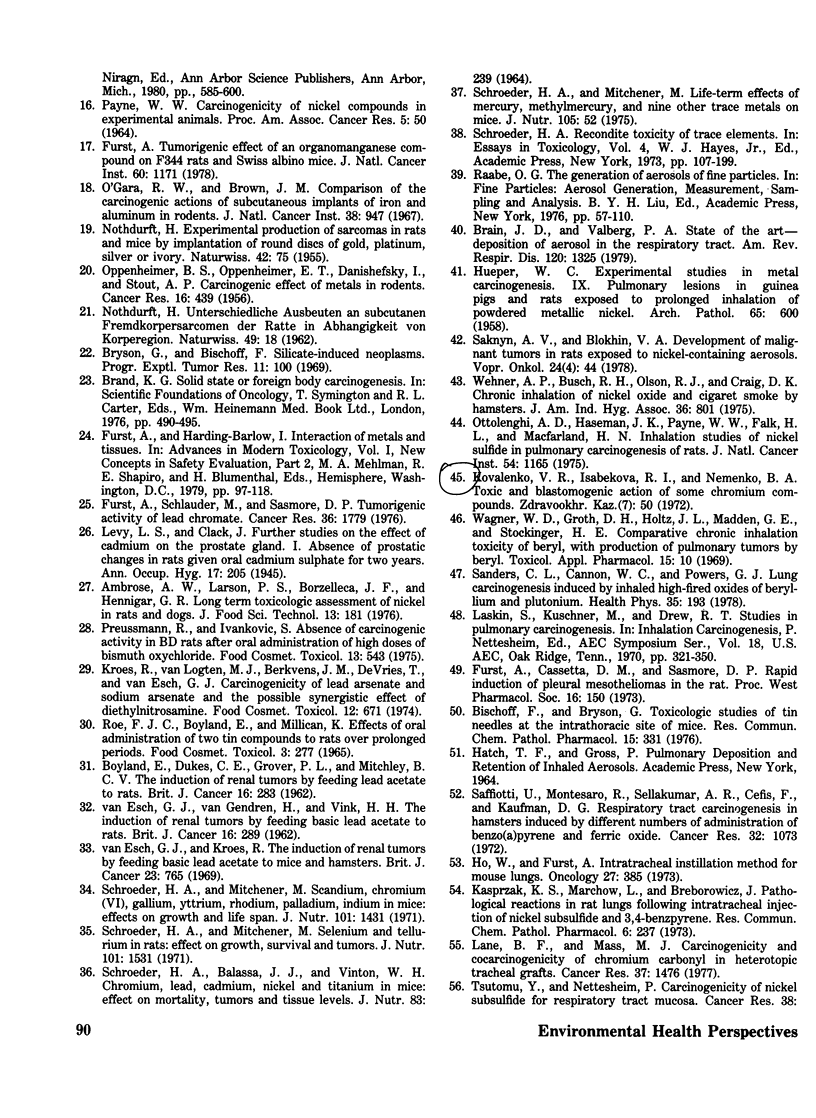
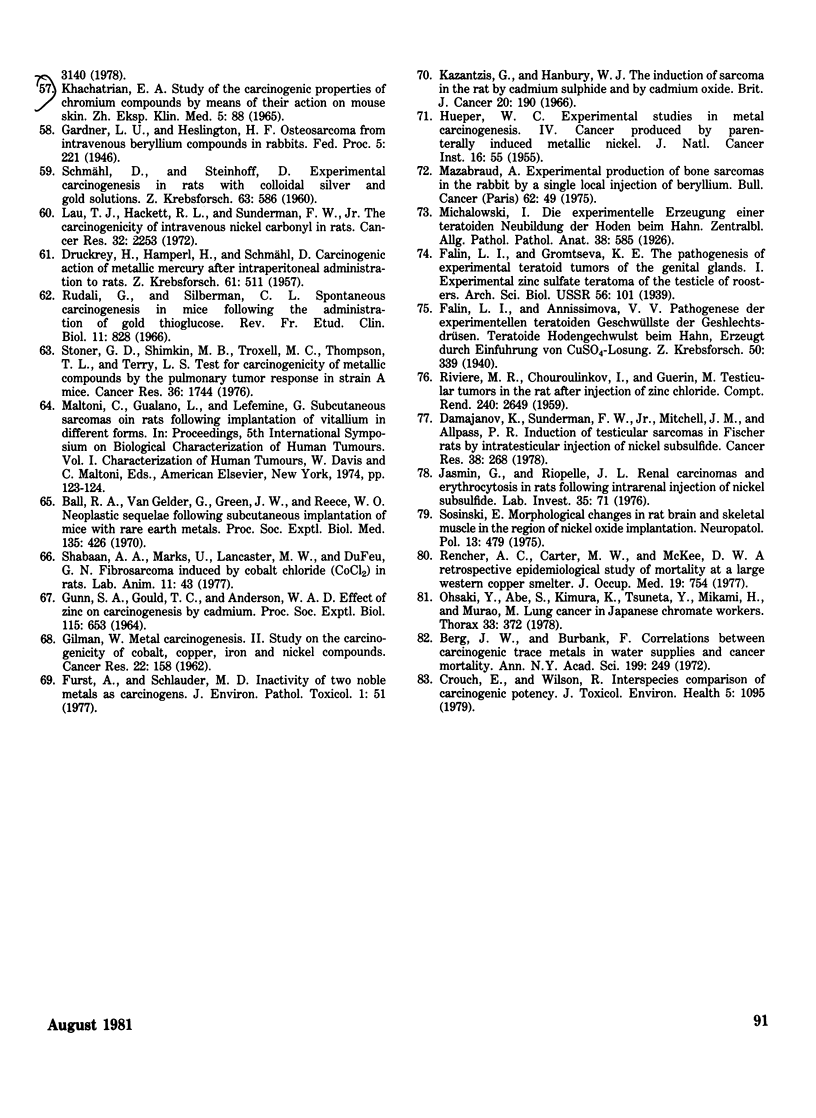
Selected References
These references are in PubMed. This may not be the complete list of references from this article.
- BOYLAND E., DUKES C. E., GROVER P. L., MITCHLEY B. C. The induction of renal tumors by feeding lead acetate to rats. Br J Cancer. 1962 Jun;16:283–288. doi: 10.1038/bjc.1962.33. [DOI] [PMC free article] [PubMed] [Google Scholar]
- Ball R. A., Van Gelder G., Green J. W., Jr, Reece W. O. Neoplastic sequelae following subcutaneous implantation of mice with rare earth metals. Proc Soc Exp Biol Med. 1970 Nov;135(2):426–430. doi: 10.3181/00379727-135-35067. [DOI] [PubMed] [Google Scholar]
- Berg J. W., Burbank F. Correlations between carcinogenic trace metals in water supplies and cancer mortality. Ann N Y Acad Sci. 1972 Jun 28;199:249–264. doi: 10.1111/j.1749-6632.1972.tb46460.x. [DOI] [PubMed] [Google Scholar]
- Bischoff F., Bryson G. Toxicologic studies of tin needles at the intrathoracic site of mice. Res Commun Chem Pathol Pharmacol. 1976 Oct;15(2):331–340. [PubMed] [Google Scholar]
- Brain J. D., Valberg P. A. Deposition of aerosol in the respiratory tract. Am Rev Respir Dis. 1979 Dec;120(6):1325–1373. doi: 10.1164/arrd.1979.120.6.1325. [DOI] [PubMed] [Google Scholar]
- Bryson G., Bischoff F. The limitations of safety testing. Prog Exp Tumor Res. 1969;11:100–133. doi: 10.1159/000391391. [DOI] [PubMed] [Google Scholar]
- Crouch E., Wilson R. Interspecies comparison of carcionogenic potency. J Toxicol Environ Health. 1979 Nov;5(6):1095–1118. doi: 10.1080/15287397909529817. [DOI] [PubMed] [Google Scholar]
- Damjanov I., Sunderman F. W., Jr, Mitchell J. M., Allpass P. R. Induction of testicular sarcomas in Fischer rats by intratesticular injection of nickel subsulfide. Cancer Res. 1978 Feb;38(2):268–276. [PubMed] [Google Scholar]
- Furst A., Haro R. T. A survey of metal carcinogenesis. Prog Exp Tumor Res. 1969;12:102–133. [PubMed] [Google Scholar]
- Furst A., Schlauder M., Sasmore D. P. Tumorigenic activity of lead chromate. Cancer Res. 1976 May;36(5):1779–1783. [PubMed] [Google Scholar]
- Furst A. Tumorigenic effect of an organomanganese compound on F344 rats and Swiss albino mice. J Natl Cancer Inst. 1978 May;60(5):1171–1173. doi: 10.1093/jnci/60.5.1171. [DOI] [PubMed] [Google Scholar]
- GILMAN J. P. Metal carcinogenesis. II. A study on the carcinogenic activity of cobalt, copper, iron, and nickel compounds. Cancer Res. 1962 Feb;22:158–162. [PubMed] [Google Scholar]
- GUNN S. A., GOULD T. C., ANDERSON W. A. EFFECT OF ZINC ON CANCEROGENESIS BY CADMIUM. Proc Soc Exp Biol Med. 1964 Mar;115:653–657. doi: 10.3181/00379727-115-28996. [DOI] [PubMed] [Google Scholar]
- HUEPER W. C. Experimental studies in metal cancerigenesis. IV. Cancer produced by parenterally introduced metallic nickel. J Natl Cancer Inst. 1955 Aug;16(1):55–73. [PubMed] [Google Scholar]
- HUEPER W. C. Experimental studies in metal cancerigenesis. IX. Pulmonary lesions in guinea pigs and rats exposed to prolonged inhalation of powdered metallic nickel. AMA Arch Pathol. 1958 Jun;65(6):600–607. [PubMed] [Google Scholar]
- Ho W., Furst A. Intratracheal instillation method for mouse lungs. Oncology. 1973;27(5):385–393. doi: 10.1159/000224748. [DOI] [PubMed] [Google Scholar]
- Kasprzak K. S., Marchow L., Breborowicz J. Pathological reactions in rat lungs following intratracheal injection of nickel subsulfide and 3,4-benzpyrene. Res Commun Chem Pathol Pharmacol. 1973 Jul;6(1):237–245. [PubMed] [Google Scholar]
- Kazantzis G., Hanbury W. J. The induction of sarcoma in the rat by cadmium sulphide and by cadmium oxide. Br J Cancer. 1966 Mar;20(1):190–199. doi: 10.1038/bjc.1966.22. [DOI] [PMC free article] [PubMed] [Google Scholar]
- Kroes R., van Logten M. J., Berkvens J. M., de Vries T., van Esch G. J. Study on the carcinogenicity of lead arsenate and sodium arsenate and on the possible synergistic effect of diethylnitrosamine. Food Cosmet Toxicol. 1974 Oct;12(5-6):671–679. doi: 10.1016/0015-6264(74)90238-7. [DOI] [PubMed] [Google Scholar]
- Lane B. P., Mass M. J. Carcinogenicity and cocarcinogenicity of chromium carbonyl in heterotopic tracheal grafts. Cancer Res. 1977 May;37(5):1476–1479. [PubMed] [Google Scholar]
- Lau T. J., Hackett R. L., Sunderman F. W., Jr The carcinogenicity of intravenous nickel carbonyl in rats. Cancer Res. 1972 Oct;32(10):2253–2258. [PubMed] [Google Scholar]
- Mazabraud A. Production expérimentale de sarcomes osseux chez le lapin par injection unique locale de Béryllium. Bull Cancer. 1975 Jan-Mar;62(1):49–58. [PubMed] [Google Scholar]
- O'Gara R. W., Brown J. M. Comparison of the carcinogenic actions of subcutaneous implants of iron and aluminum in rodents. J Natl Cancer Inst. 1967 Jun;38(6):947–957. [PubMed] [Google Scholar]
- OPPENHEIMER B. S., OPPENHEIMER E. T., DANISHEFSKY I., STOUT A. P. Carcinogenic effect of metals in rodents. Cancer Res. 1956 Jun;16(5):439–441. [PubMed] [Google Scholar]
- Ohsaki Y., Abe S., Kimura K., Tsuneta Y., Mikami H., Murao M. Lung cancer in Japanese chromate workers. Thorax. 1978 Jun;33(3):372–374. doi: 10.1136/thx.33.3.372. [DOI] [PMC free article] [PubMed] [Google Scholar]
- Ottolenghi A. D., Haseman J. K., Payne W. W., Falk H. L., MacFarland H. N. Inhalation studies of nickel sulfide in pulmonary carcinogenesis of rats. J Natl Cancer Inst. 1975 May;54(5):1165–1172. doi: 10.1093/jnci/54.5.1165. [DOI] [PubMed] [Google Scholar]
- Preussmann R., Ivankovic S. Absence of carcinogenic activity in BD rats after oral administration of high doses of bismuth oxychloride. Food Cosmet Toxicol. 1975 Oct;13(5):543–544. doi: 10.1016/0015-6264(75)90010-3. [DOI] [PubMed] [Google Scholar]
- RIVIERE M. R., CHOUROULINKOV I., GUERIN M. [Tumors of the testicle in the rat after injection of zinc chloride]. C R Hebd Seances Acad Sci. 1959 Dec 9;249:2649–2651. [PubMed] [Google Scholar]
- Rencher A. C., Carter M. W., McKee D. W. A retrospective epidemiological study of mortality at a large western copper smelter. J Occup Med. 1977 Nov;19(11):754–758. [PubMed] [Google Scholar]
- Roe F. J., Boyland E., Millican K. Effects of oral administration of two tin compounds to rats over prolonged periods. Food Cosmet Toxicol. 1965 Aug;3(2):277–280. doi: 10.1016/s0015-6264(65)80085-2. [DOI] [PubMed] [Google Scholar]
- SCHROEDER H. A., BALASSA J. J., VINTON W. H., Jr CHROMIUM, LEAD, CADMIUM, NICKEL AND TITANIUM IN MICE: EFFECT ON MORTALITY, TUMORS AND TISSUE LEVELS. J Nutr. 1964 Jul;83:239–250. doi: 10.1093/jn/83.3.239. [DOI] [PubMed] [Google Scholar]
- Saffiotti U., Montesano R., Sellakumar A. R., Cefis F., Kaufman D. G. Respiratory tract carcinogenesis in hamsters induced by different numbers of administrations of benzo(a)pyrene and ferric oxide. Cancer Res. 1972 May;32(5):1073–1081. [PubMed] [Google Scholar]
- Saknyn' A. V., Blokhin V. A. O razvitii zlokachestvennykh opukholei u krys pod vliianiem nikel'soderzhashchikh érozolei. Vopr Onkol. 1978;24(4):44–48. [PubMed] [Google Scholar]
- Sanders C. L., Cannon W. C., Powers G. J. Lung carcinogenesis induced by inhaled high-fired oxides of beryllium and plutonium. Health Phys. 1978 Aug;35(2):193–199. doi: 10.1097/00004032-197808000-00001. [DOI] [PubMed] [Google Scholar]
- Schroeder H. A., Mitchener M. Scandium, chromium(VI), gallium, yttrium, rhodium, palladium, indium in mice: effects on growth and life span. J Nutr. 1971 Oct;101(10):1431–1437. doi: 10.1093/jn/101.10.1431. [DOI] [PubMed] [Google Scholar]
- Schroeder H. A., Mitchener M. Selenium and tellurium in rats: effect on growth, survival and tumors. J Nutr. 1971 Nov;101(11):1531–1540. doi: 10.1093/jn/101.11.1531. [DOI] [PubMed] [Google Scholar]
- Shabaan A. A., Marks V., Lancaster M. C., Dufeu G. N. Fibrosarcomas induced by cobalt chloride (CoCl2) in rats. Lab Anim. 1977 Jan;11(1):43–46. doi: 10.1258/002367777780959157. [DOI] [PubMed] [Google Scholar]
- Sosiński E. Morphological changes in rat brain and skeletal muscle in the region of nickel oxide implantation. Neuropatol Pol. 1975 Jul-Dec;13(3-4):479–483. [PubMed] [Google Scholar]
- Stoner G. D., Shimkin M. B., Troxell M. C., Thompson T. L., Terry L. S. Test for carcinogenicity of metallic compounds by the pulmonary tumor response in strain A mice. Cancer Res. 1976 May;36(5):1744–1747. [PubMed] [Google Scholar]
- Sunderman F. W., Jr Carcinogenic effects of metals. Fed Proc. 1978 Jan;37(1):40–46. [PubMed] [Google Scholar]
- Sunderman F. W., Jr Metal carcinogenesis in experimental animals. Food Cosmet Toxicol. 1971 Feb;9(1):105–120. doi: 10.1016/s0015-6264(71)80120-7. [DOI] [PubMed] [Google Scholar]
- Sunderman J. W., Jr A review of the carcinogenicities of nickel, chromium and arsenic compounds in man and animals. Prev Med. 1976 Jun;5(2):279–294. doi: 10.1016/0091-7435(76)90045-1. [DOI] [PubMed] [Google Scholar]
- Van Esch G. J., Kroes R. The induction of renal tumours by feeding basic lead acetate to mice and hamsters. Br J Cancer. 1969 Dec;23(4):765–771. doi: 10.1038/bjc.1969.95. [DOI] [PMC free article] [PubMed] [Google Scholar]
- Wagner W. D., Groth D. H., Holtz J. L., Madden G. E., Stokinger H. E. Comparative chronic inhalation toxicity of beryllium ores, bertrandite and beryl, with production of pulmonary tumors by beryl. Toxicol Appl Pharmacol. 1969 Jul;15:10–29. doi: 10.1016/0041-008x(69)90127-6. [DOI] [PubMed] [Google Scholar]
- Wehner A. P., Busch R. H., Olson R. J., Craig D. K. Chronic inhalation of nickel oxide and cigarette smoke by hamsters. Am Ind Hyg Assoc J. 1975 Nov;36(11):801–810. doi: 10.1080/0002889758507346. [DOI] [PubMed] [Google Scholar]
- van ESCH G., van GENDEREN, VINK H. H. The induction of renal tumours by feeding of basic lead acetate to rats. Br J Cancer. 1962 Jun;16:289–297. doi: 10.1038/bjc.1962.34. [DOI] [PMC free article] [PubMed] [Google Scholar]


